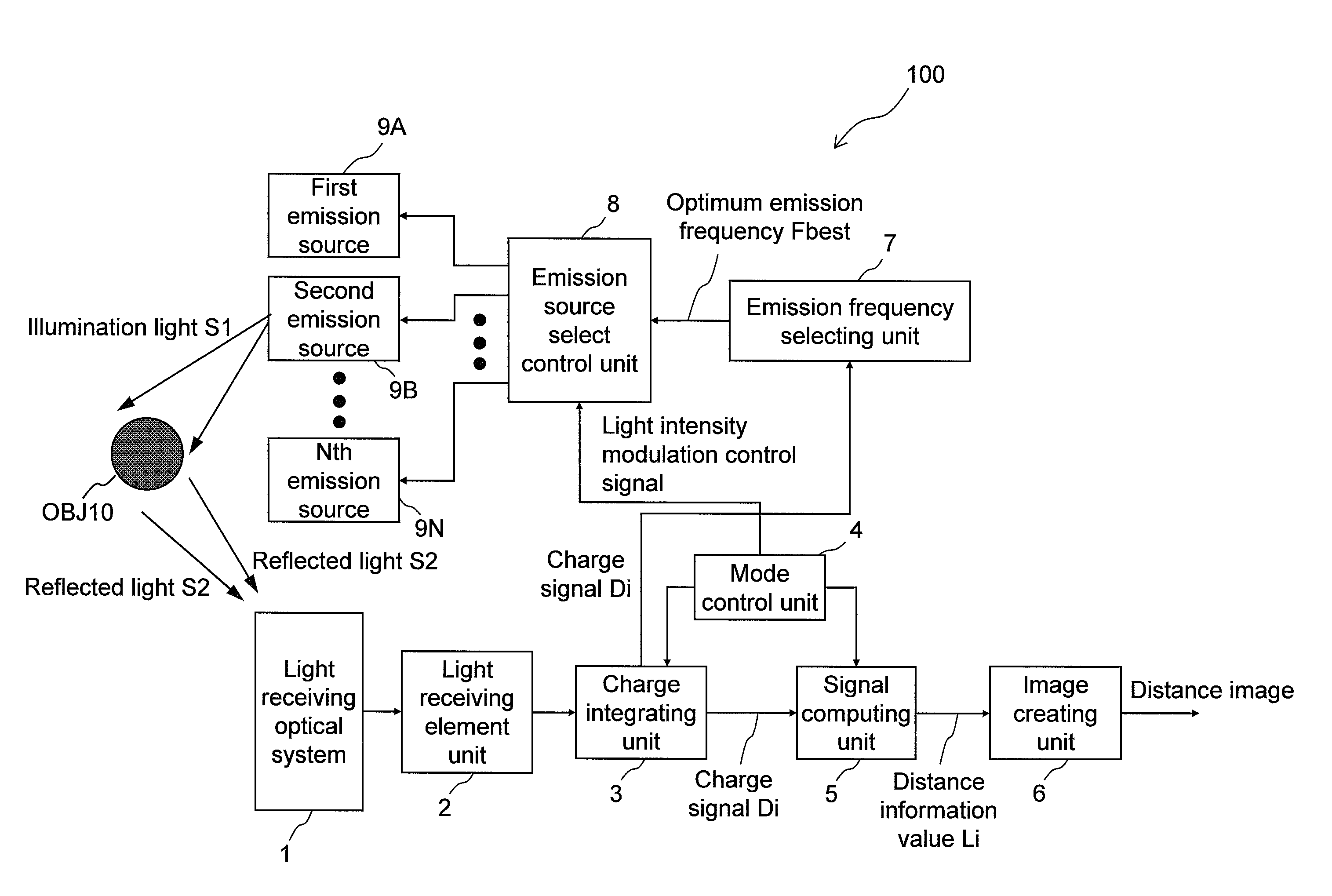Distance estimating device, distance estimating method, program, integrated circuit, and camera
a technology of distance estimation and distance, which is applied in closed circuit television systems, instruments, television systems, etc., can solve the problems of unsuitable triangular methods, unsuitable application, and it is difficult to uniquely determine the result of distance calculation, etc., and achieves high resolution, high frame rate, and high precision
- Summary
- Abstract
- Description
- Claims
- Application Information
AI Technical Summary
Benefits of technology
Problems solved by technology
Method used
Image
Examples
first embodiment
[0124]With reference to FIGS. 1 through 5, a distance estimating device and a distance estimating method, in which light reflected from an object with no light being emitted from the light source is received, illumination light having an emission frequency which is insusceptible to environment light is selected based on a result of a frequency analysis of the reflected light, and the illumination light having the selected emission frequency is used to obtain a distance image to the object, are described as the first embodiment of the present invention.
[0125]
[0126]FIG. 1 is a schematic block diagram of a distance estimating device 100 according to the first embodiment of the present invention. FIG. 2 is a diagram showing a structure of an emission frequency selecting unit 7 in the distance estimating device which is an example of the first embodiment of the present invention. FIG. 3 is a diagram showing an outline of a method for selecting an emission frequency of a light source in t...
second embodiment
[0185]With reference to FIGS. 6 through 11, a distance estimating device and a distance estimating method for performing a distance estimating process by a light source having an insusceptible emission frequency based on an environment light distribution within an object region extracted from a color image are described as the second embodiment of the present invention.
[0186]FIG. 6 is a schematic diagram showing a structure of a distance estimating device 200 according to the second embodiment of the present invention. FIGS. 10 and 11 are schematic diagrams showing object region extracting units 14 and 14A of the distance estimating device 200 according to the second embodiment of the present invention.
[0187]FIG. 7 is a schematic diagram showing an outline of a method for selecting an emission frequency of a light source in the distance estimating method according to the second embodiment. FIG. 8 is a flow diagram of the distance estimating method according to the second embodiment....
third embodiment
[0240]With reference to FIGS. 12 through 15, a distance estimating device which uses a light source having an emission frequency with has less influence based on environment light distribution in an object region extracted from a color image and a distance estimating method as the third embodiment of the present invention.
[0241]FIGS. 12 and 15 shows object region extracting units 14B and 14C in the distance estimating device according to the third embodiment of the present invention.
[0242]FIG. 13 is a diagram showing a summary of a classifying method in the object region extracting units 14B and 14C in the distance estimating device according to the third embodiment. FIG. 14 is a schematic view showing how candidate pixel is extracted, classified and candidate region is detected in the distance estimating device according to the third embodiment. Components similar to those in the above embodiments are denoted by the same reference numerals, and the descriptions thereof are omitted....
PUM
 Login to View More
Login to View More Abstract
Description
Claims
Application Information
 Login to View More
Login to View More - R&D
- Intellectual Property
- Life Sciences
- Materials
- Tech Scout
- Unparalleled Data Quality
- Higher Quality Content
- 60% Fewer Hallucinations
Browse by: Latest US Patents, China's latest patents, Technical Efficacy Thesaurus, Application Domain, Technology Topic, Popular Technical Reports.
© 2025 PatSnap. All rights reserved.Legal|Privacy policy|Modern Slavery Act Transparency Statement|Sitemap|About US| Contact US: help@patsnap.com



